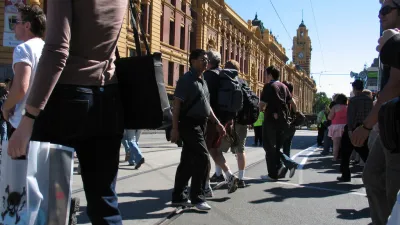A post on Ars Technica digs into the complicated world of pedestrian modeling and identifies a culprit in the problems with existing models: indecisive people.

Chris Lee introduces the research of Alessandro Corbetta, from the Technical University of Eindhoven, into the difficulties of creating reliable models for pedestrian behavior.
The problem:
Unfortunately, pedestrian models are not very well tested against data. Most experiments involve paying university students to walk along corridors and through doors under highly artificial conditions. In part, this is because it has been very difficult to obtain data from natural settings, where you need to track individual pedestrians as they walk through some area of interest.
The solution:
Corbetta set [Kinect] cameras up in two locations: the main thoroughfare at Eindhoven train station and a link corridor between one of the university buildings and the nearest cafeteria. From there, he recorded data for a year.
Corbetta's findings after crunching the quarter of a million trajectories he discovered during the experiment revealed some of the behavior that makes pedestrian modeling so difficult. Namely, that some people change their minds en route, and turn around. The article goes into more detail about how Corbetta accounted for their indecision for the ongoing project of building reliable pedestrian models.
FULL STORY: Models of pedestrian flow stumble because people change their minds

National Parks Layoffs Will Cause Communities to Lose Billions
Thousands of essential park workers were laid off this week, just before the busy spring break season.

Retro-silient?: America’s First “Eco-burb,” The Woodlands Turns 50
A master-planned community north of Houston offers lessons on green infrastructure and resilient design, but falls short of its founder’s lofty affordability and walkability goals.

Delivering for America Plan Will Downgrade Mail Service in at Least 49.5 Percent of Zip Codes
Republican and Democrat lawmakers criticize the plan for its disproportionate negative impact on rural communities.

Test News Post 1
This is a summary

Test News Headline 46
Test for the image on the front page.

Balancing Bombs and Butterflies: How the National Guard Protects a Rare Species
The National Guard at Fort Indiantown Gap uses GIS technology and land management strategies to balance military training with conservation efforts, ensuring the survival of the rare eastern regal fritillary butterfly.
Urban Design for Planners 1: Software Tools
This six-course series explores essential urban design concepts using open source software and equips planners with the tools they need to participate fully in the urban design process.
Planning for Universal Design
Learn the tools for implementing Universal Design in planning regulations.
EMC Planning Group, Inc.
Planetizen
Planetizen
Mpact (formerly Rail~Volution)
Great Falls Development Authority, Inc.
HUDs Office of Policy Development and Research
NYU Wagner Graduate School of Public Service





























